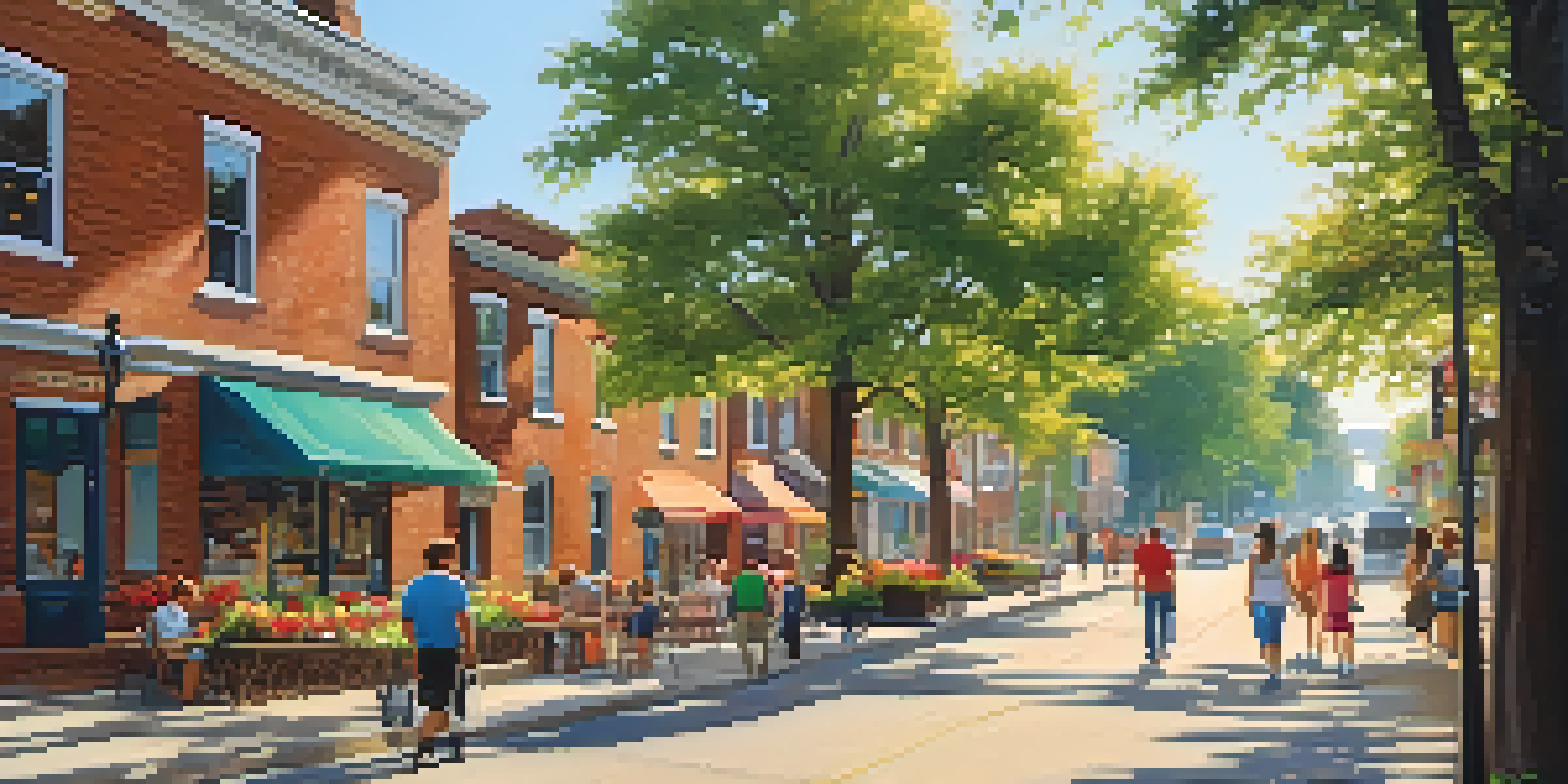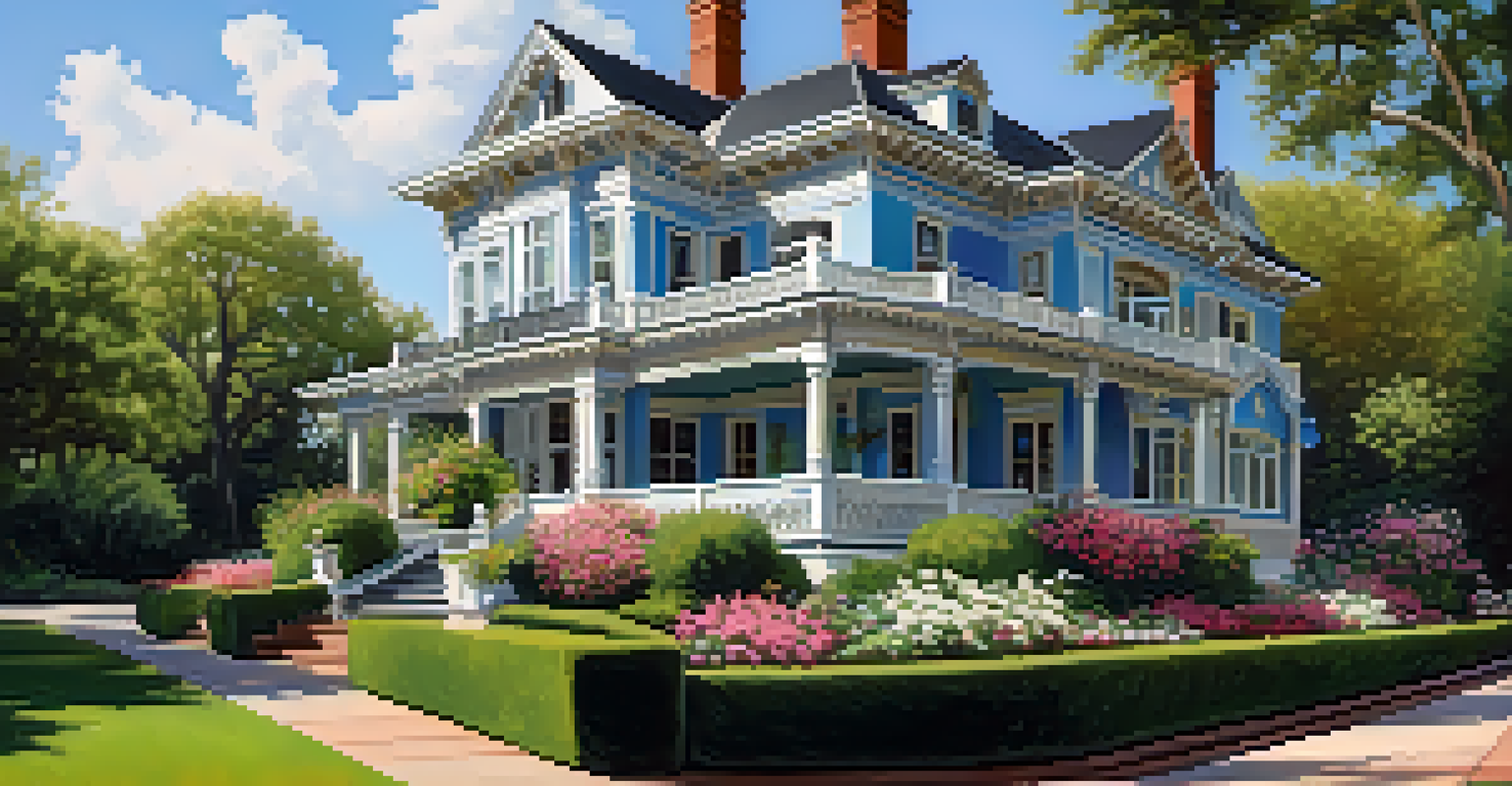Understanding the Benefits of Preserving Historic Neighborhoods

The Cultural Heritage of Historic Neighborhoods
Historic neighborhoods are living museums, showcasing the architectural styles and cultural narratives of their time. They tell stories of the people who lived there, reflecting the social and economic history of the area. By preserving these neighborhoods, we maintain a tangible connection to our past, allowing future generations to learn and appreciate their heritage.
Preservation is the key to understanding the past; without it, we lose the stories that connect us.
Each building and street corner can evoke memories and emotions, weaving a rich tapestry of community life. For instance, a quaint coffee shop in a historic district might remind residents of their childhood experiences or family gatherings. These shared memories foster a sense of belonging and strengthen community ties, making preservation a communal effort.
Moreover, cultural heritage can become a source of pride for residents, enhancing their identity and sense of place. When people recognize the value of their neighborhood's history, they are more likely to engage in its preservation, ensuring that the stories of their community are not forgotten.
Economic Benefits of Historic Preservation
Preserving historic neighborhoods can have a significant positive impact on local economies. When these areas are maintained, they often attract tourists who are eager to explore their charm and history. This influx of visitors can boost local businesses, from restaurants to shops, creating jobs and generating revenue.

Additionally, property values in well-preserved historic neighborhoods tend to rise. Homebuyers often seek out unique, character-filled homes rather than cookie-cutter developments, making these neighborhoods highly desirable. This increase in demand can lead to higher property tax revenues, which can then be reinvested into the community.
Historic Neighborhoods Foster Pride
Preserving historic neighborhoods enhances community identity and encourages residents to engage in preservation efforts.
Furthermore, grants and tax incentives for restoration projects can provide financial support for homeowners and businesses. By investing in the preservation of historic structures, communities can create a sustainable economic cycle that benefits everyone involved.
Environmental Sustainability Through Preservation
Preserving historic neighborhoods can significantly contribute to environmental sustainability. By renovating existing buildings instead of demolishing and rebuilding, we reduce waste and minimize the carbon footprint associated with new construction. This approach is not only eco-friendly but also preserves the character of the community.
Historic preservation is not just about saving buildings; it's about saving the stories of the people who lived in them.
Historic buildings often utilize materials and construction techniques that are more energy-efficient than modern methods. For example, thick walls and high ceilings can help regulate temperature without relying heavily on heating and cooling systems. This inherent efficiency leads to lower energy costs and a smaller environmental impact.
Moreover, maintaining these neighborhoods encourages walkability and public transit use. Well-preserved areas often feature mixed-use developments, fostering a vibrant community where residents can easily access shops, parks, and services without the need for a car. This reduces traffic congestion and promotes a healthier lifestyle.
Community Engagement and Pride
Historic preservation fosters community engagement, as residents often come together to advocate for their neighborhood. This collaboration can lead to stronger relationships among neighbors, creating a sense of camaraderie. When people work collectively towards a common goal, they develop pride in their community and its history.
Events such as neighborhood clean-ups, historical tours, or restoration workshops can further strengthen these bonds. They not only promote awareness of the neighborhood's significance but also provide opportunities for residents to learn from one another. Such engagement can lead to a more vibrant and active community.
Economic Growth from Preservation
Maintaining historic neighborhoods attracts tourism and boosts local economies by increasing property values and creating jobs.
Additionally, when residents feel a sense of ownership over their neighborhood's history, they are more likely to take an active role in its preservation. This grassroots involvement can lead to lasting change, ensuring that community voices are heard in decisions that affect their environment.
Enhancing Quality of Life through Preservation
Preserved historic neighborhoods often offer a unique quality of life that modern developments can lack. The character of these areas creates a sense of charm and aesthetic appeal, making them enjoyable places to live and visit. Tree-lined streets, quaint architecture, and public spaces contribute to a more pleasant living environment.
Moreover, these neighborhoods often feature a strong sense of community. Residents are more likely to know their neighbors and participate in local events, fostering a tight-knit atmosphere. This social interaction plays a crucial role in overall well-being and happiness.
Furthermore, access to parks, cultural institutions, and local businesses enhances the quality of life for residents. Historic neighborhoods often have a wealth of amenities within walking distance, promoting a healthier lifestyle and reducing reliance on vehicles.
Educational Opportunities in Historic Neighborhoods
Historic neighborhoods serve as valuable educational resources for both residents and visitors. They provide hands-on experiences that can help people understand local history and culture in a way that textbooks cannot. Schools often take advantage of these neighborhoods by organizing field trips that explore their significance.
These areas can also host workshops, lectures, and community events centered around history and preservation. Such initiatives can engage individuals of all ages, sparking interest in local heritage and encouraging lifelong learning. For example, a historic home may offer tours that delve into architectural styles and the lives of previous residents.
Sustainable Practices in Preservation
Renovating existing structures promotes environmental sustainability by reducing waste and encouraging walkability.
By fostering a culture of education and appreciation for history, preserved neighborhoods can instill a sense of responsibility in the community. Residents may feel compelled to protect their heritage, ensuring that future generations can learn from and enjoy these historic spaces.
Challenges in Preserving Historic Neighborhoods
Despite the many benefits of preserving historic neighborhoods, there are challenges that communities must navigate. Gentrification, for instance, can threaten the very fabric of these areas, as rising property values may push out long-time residents. Balancing development with preservation is a delicate task that requires careful planning and community input.
Additionally, funding for preservation projects can be limited. While grants and tax incentives exist, they may not cover all the necessary costs associated with restoration. Communities often need to seek alternative funding sources or rely on volunteers, which can be daunting.

Lastly, there's the challenge of maintaining the integrity of historic structures while meeting modern needs. This might involve finding a way to incorporate updated amenities without compromising the architectural character. Successful preservation requires collaboration between architects, community members, and local governments to ensure that the spirit of the neighborhood is honored.
The Future of Historic Neighborhoods
Looking ahead, the future of historic neighborhoods will likely involve a blend of preservation and innovation. As communities recognize the value of their heritage, there may be a greater push for policies that support sustainable development while preserving historical significance. This can result in a more thoughtful approach to urban planning.
Technology can also play a vital role in preservation efforts. Digital tools, such as virtual tours and online archives, can help document and promote historic neighborhoods, attracting interest from a wider audience. Engaging younger generations through technology can spark their interest in local history and preservation.
Ultimately, the future of historic neighborhoods depends on the collective commitment of community members, policymakers, and preservationists. By working together, they can ensure that these vibrant spaces continue to thrive, blending the charm of the past with the needs of the present.